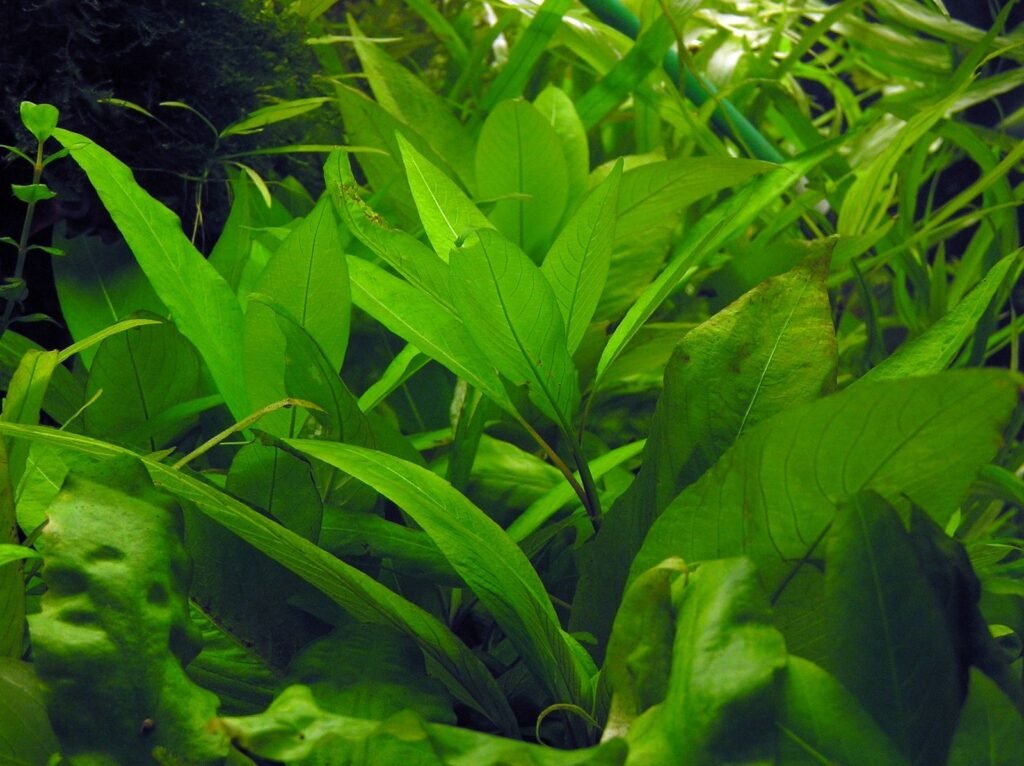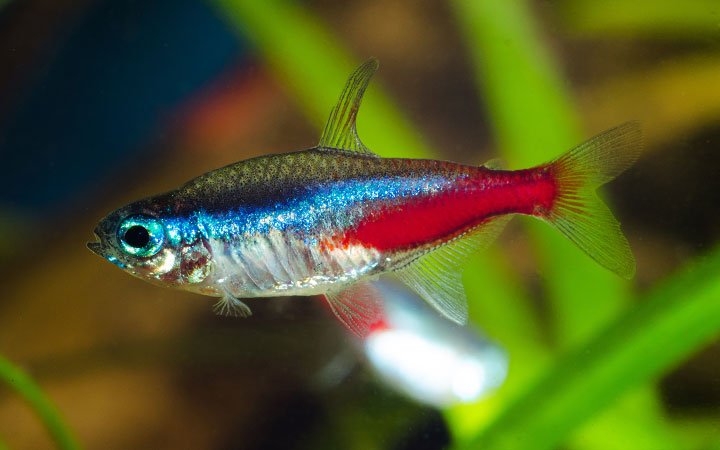Hygrophila corymbosa, also know as Temple Plant, is a aquatic plant easy and agile to maintain in a freshwater aquarium. The Hygrophila corymbosa is a ideal plant to keep inside a giant aquarium looks fantastic in large aquariums. It usually develops underwater, but it can grow and emerge above water, sprouting purple flowers. It can be kept in great shape, but sometimes the leaves can fall out. This plant propagates quickly inside your freshwater tank, creating spectacular, green, and massive growth right before your eyes. All varieties of the species share the same main characteristics, such as requiring a good amount of lighting and generally flourishing in larger structures.
Summary
The aquatic plant Hygrophila corymbosa are suitable options for beginner hobbyists into planted tanks. It is flexible and adaptable and flourishes in virtually all water conditions. If you need to keep your aquariums looking flawless with lots of water, it can be an excellent solution to this problem.
What is Hygrophila?
Hygrophila is also known as Temple Plant, Giant Hygro or Marsh Plant. The genus Hygrophila contains about 100 species, some of which are aquatic. Some species and hybrids are invasive animals, while many varieties and species are widespread in aquariums.
Habitat
The Giant Hygro (Hygrophila corymbosa), as it is sometimes called, it is suitable to start your hobby of maintaining aquariums with plants. It is not a demanding aquatic plant and is adaptable to different water parameters in aquariums or other selected locations.
Tank Mates and compatibility
It is ideal as tank mates to many species of aquariums, although your plant needs careful handling to be kept in a tank with herbivorous fish. Most of the time, herbivorous freshwater fish can nibble on plant leaves.
Placement in a Tank
Most Hygrophila corymbosa cultivars generally do well in aquariums, and the plant with its tall, temple-like top is perfect for placing in the tank’s background region.
Hygrophila corymbosa: Planting, Care, Propagation & Height
Another feature that a well-designed aquarium offers its inhabitants is the presence of plants. Hygrophila corymbosa will also serve as a source of shelter for protection and a secondary source of food for the tank’s fish, allowing them to live in a suitable location that resembles their natural environment. Of course, it’s always good to start with beginner-friendly plants like Hygrophila corymbosa, or popularly known as Giant Hygro.
Hygrophila corymbosa
Hygrophila corymbosa (Temple Plant) is an easy-to-care aquatic plant that hails from the Asian regions. Its flowers are purple and can grow above water level, so domestic aquariums are not standard. In your aquarium, it spreads quickly, forming forms with its light green leaves, deep and thick, and growing towards the surface. Some species and cultivars also have pink or magenta leaves and flowers, particularly interesting in aquariums. The new stems that sprout from the plants spread through the bushes, creating a thick, compact appearance; the plant will be an excellent application for forming aquatic landscapes.
Growing conditions
Hygrophila corymbosa lives well at a pH around 6.0 to 7.5 and hardness around 2 to 15 dGh. It is crucial to use intense light to encourage optimal growth, as its habitat does not develop softer lighting. The water will have temperatures between 64 and 86 degrees F. There should also be enough nutrients in the aquarium for these aquarium plantings so they can grow to their fullest and maintain their beautiful, eye-catching appearance. Hygrophila corymbosa also benefit from the use of CO2 for plants. It is ideal for the best light conditions, but it can be kept in moderate light conditions.
Hygrophila corymbosa Care
Most other subspecies and cultivars of Hygrophila corymbosa share common characteristics. Hygrophila corymbosa can grow to over 15 inches tall in the natural habitat, although in most aquariums, the plant should grow to about ten inches tall. The naturally occurring Hygrophila corymbosa is found in all South Asian countries, including Thailand, Malaysia, Singapore, Indonesia, and India. When submerged in water with optimal conditions, it produces pink or purple flowers. Plants can turn grayish-green, pink, and purple depending on their underwater position and the incidence of light and nutrients.
Propagation and reproduction
Another essential aspect of caring for the Giant Hygro plant involves propagation – most notably the increase in large side shoots that will need to be pruned for the plant to maintain its erect architecture, but this depends on the tank’s design. These pruned shoots can be buried in the substrate; this is the main form of artificial propagation of this plant. Due to its rapid expansion and growth, it may be necessary to carry out pruning even weekly. When cutting new seedlings, remove a few leaves from each branch—roots from around the nodes, which helps the plants remain stable. You can start finding new roots in a few days. The plants spread new shoots and start to look like little shrubs.
Why Hygrophila corymbosa plant?
This simple stem plant offers fantastic underwater views when combined with other aquatic plants and animals. Giant Hygro is a stem plants that produce different color patterns, ranging from dark green to pink and magenta. However, these displayed colors are subject to other factors such as lighting, supplementation, and strict care measures. This stem plant often produces beautiful purple flowers while remaining in full force. These plants emit a bright green color for an abundance of pure simplicity that dominates aquascaping.
Ideal Tank Requirements and Conditions
The researchers explain that aquatic plants differ somewhat from terrestrial plants. It takes longer to keep a certain number of plants stable in a pond that needs regular cleaning and specialized treatments. Some plants require more care; others are less.
Propagation instructions
A large formation in a forest is possible underwater in your aquariums. Most aquarium hobbyists prefer broadleaf plant. Trim off excess plants and shoots for harmonious support. You can pair your Giant Hygro with Cryptocoryne and some types of school fish like cyprinids, including Rasboras. This harmony in our tanks is pleasant and comforting! If the pruning cut is done correctly, the side shoots will no longer grow, so the edges of the bushes will be visible.
Care and maintenance
The Hygrophila exhibit new growth very quickly and requires almost no extra maintenance. Water changes and the addition of liquid fertilizer will stimulate healthy new growth in the plants. Then you can prune your plant as soon as possible. Pruning helps the plant grow stronger, generating new healthy parts and shooting new shoots. During the day, Hygrophila plant grows happily even in poor lighting. To increase plant density, growth, or change color, you should use specific lighting and a CO² injection system.
Compatibility
Hygrophila plant grows in a pond with lots of snails, shrimp, and fish, as long as they are not predatory animals. You should avoid keeping these plants with heavily herbivorous animals (such as goldfish). Goldfish will also eat virtually all of its various aquatic plants, branches, and leaves. Some fish also easily remove the plant from the substrate. These plants, when constantly attacked, will eventually perish.
Tank size
These plants are highly recommended for those with limited knowledge who maintain these plant. The species has almost all the characteristics suitable for a beginning or intermediate grower. Hygrophila tends to spread very quickly as it adapts to the tank.
Hygrophila corymbosa 101
Hygrophila corymbosa is a plant with a long, slender stem with long, lanceolate leaves and a slightly rounded base. For growing in ponds, plants usually measure between 4-10 inches in height. Its leaves have bright green leaves, which darken during intense exposure to the sun. Temple plants multiply quickly if the environment is provided to meet the ideal needs to become dense and showy for long periods. When viewed from nature, when partially submerged, this plant produces pink flowers.
Appearance of some cultivar
Plants of the Compact variety (or Kompakt) are darker brown in tone in the early stages. The temple’s narrow-leaved varieties can quickly grow in size, giving it bright green colors and bronze hues. Offer the plant a tank that looks like its own miniature aquatic natural environment inside the aquarium. This is not a aquarium plant with different cultivars that is very difficult to observe in nature. Other varieties have been dubbed the fast-growing “giant” plant.

Benefits it can bring to your aquarium
There are several benefits to adding plant species to aquariums. Tropical aquariums plant can help absorb and reduce nitrogen, ammonia, and other nutrients, helping to keep this amount at optimal levels, so they are not toxic to the fish in your tank. In other words, by consuming the nutrients dispersed in water, they can also reduce unwanted algae growth. Hygrophila can be part of a vast underwater garden for your aquarium with minimal costs, allowing easy tank maintenance.
How to care for Hygrophila in your aquarium?
Having this simple plant in your aquarium means receiving a beautiful aesthetic in exchange for easy care! Aquarium plants provide a stunning aesthetic beauty to any aquarium, as well as hiding places, food sources, and breeding sites for fish. This guide focuses on some tropical aquarium plants belonging to Hygrophila corymbosa. Plants can quickly be grown and cared for individually and can be readily purchased at an excellent local specialty store, giving them an efficient selection as a beginning aquarist. They can take up most of a tank, especially if it’s small in volume.
Growth rate
Both ‘Kompakt’ and ‘Temple Narrow Leaf’ cultivars have light green foliage that provides outstanding aesthetic beauty and is well suited to maintain an environment efficiently designed for them. Kompakt plants grow much slower than classic Temple plants, and the stems are shorter. You will observe both cultivars growing several centimeters per month, and it is stated that the temple variation can reach several meters in height.
Conclusion
Temple Plants kept in aquariums in perfect condition become colorful and showy. Until the requirements of the aquarium, the substrate, and the environment can be balanced, there is a small probability that the plant will stop its growth and never develop. Maintaining planted tanks and plants in aquariums is a beautiful hobby but challenging one. Every effort is worth seeing what comes out of your work in a very well-planned but extremely conceptual aquarium. There are few plants with a beauty comparable to the green of Hygrophila corymbosa, allowing for peaceful and relaxing views.





![[Updated 2023] Top 7 Best Reef Salt For LPS, SPS Corals Reef Tank [Updated 2023] Top 7 Best Reef Salt For LPS, SPS Corals Reef Tank](https://aquariumhunter.com/wp-content/uploads/2021/06/Best.jpg)

